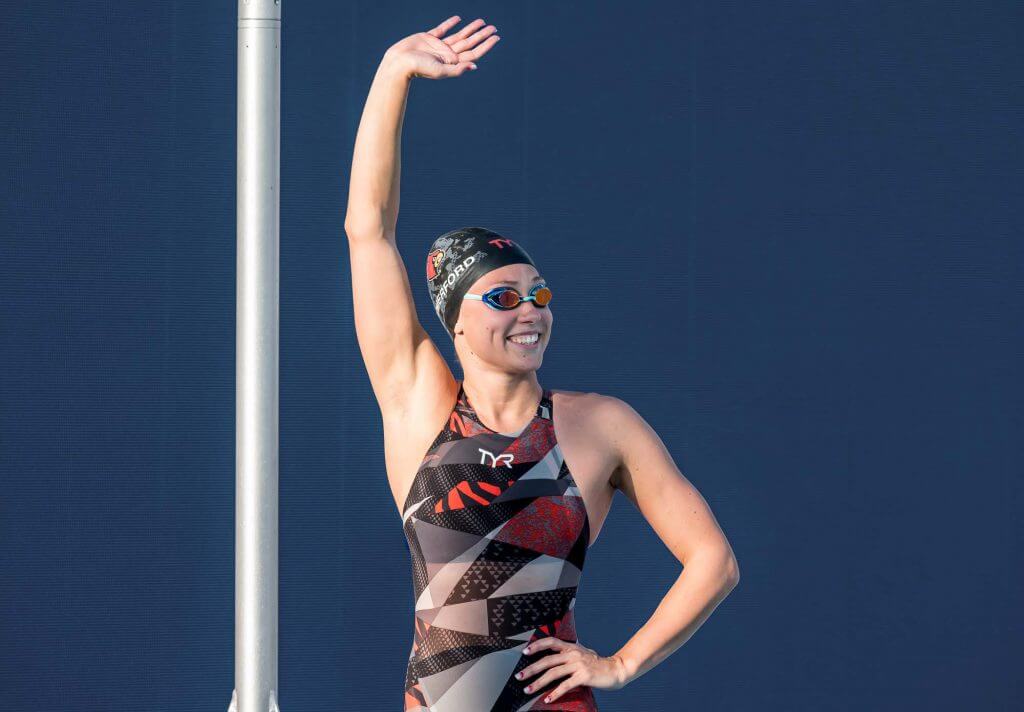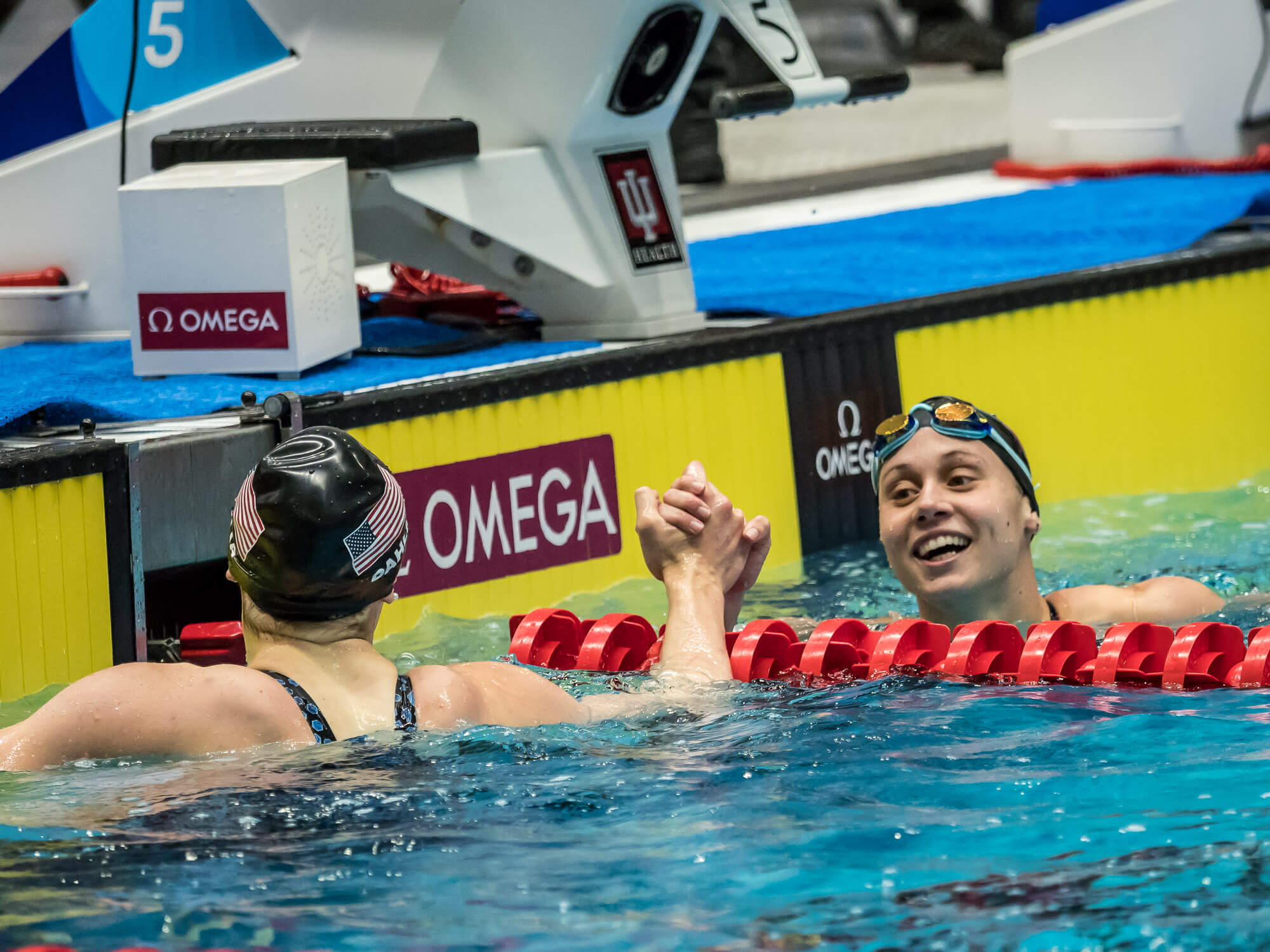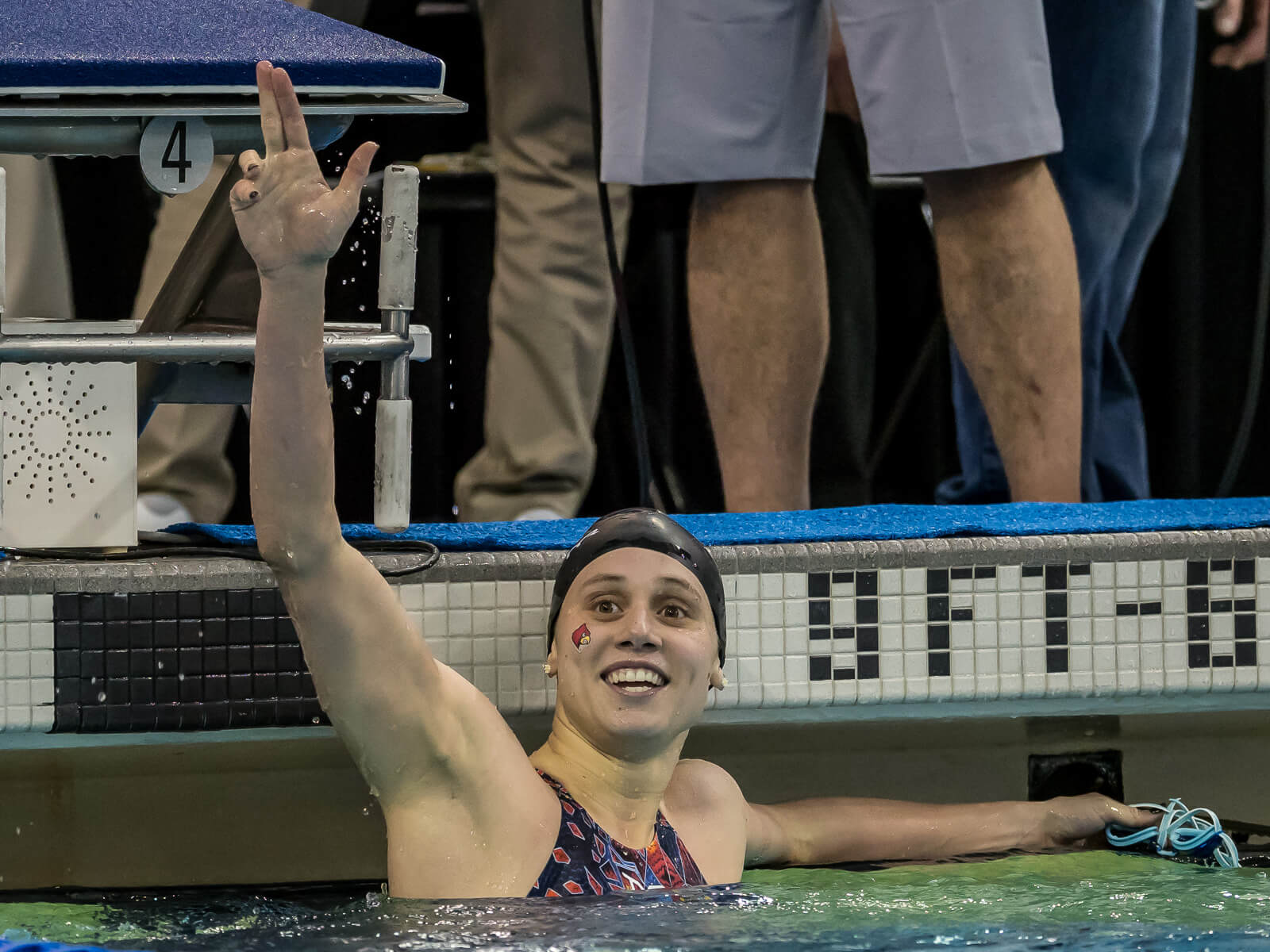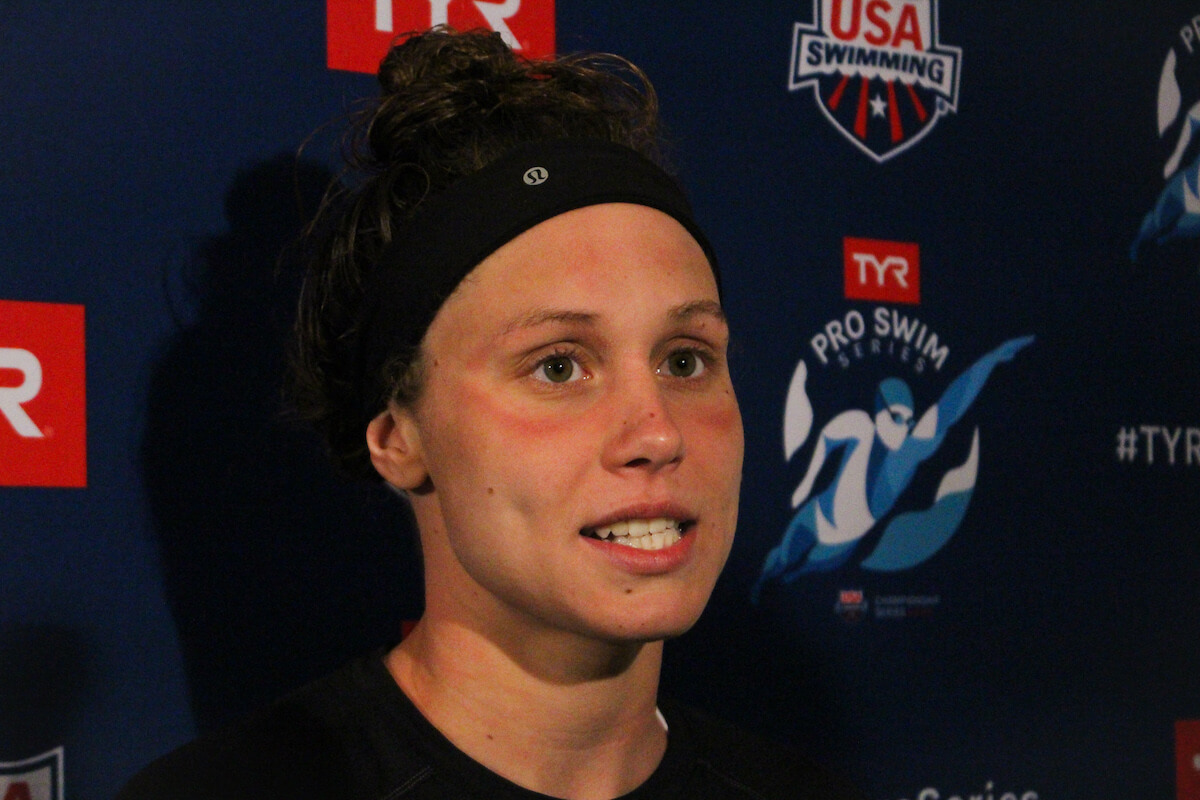Mallory Comerford’s Elations and Frustrations Lead to Final NCAA Championships

Editorial content for the 2019 NCAA DI Championship coverage is sponsored by SwimOutlet.com. See full event coverage.

Mallory Comerford vividly remembers the moment she realized she had reached a truly elite level in swimming. Her good friend and Louisville teammate Kelsi Dahlia was one lane over. In the same pool where she had shocked the country by tying with Katie Ledecky for the 200 free NCAA title three months earlier, Comerford was aiming for a spot on her first U.S. international team.
In two years as a collegian, the lightly-heralded recruit from Kalamazoo, Mich., had quickly morphed into one of the country’s best 100 and 200 freestylers, but long course was foreign territory. She arrived at Louisville with hardly any experience in the 50-meter course, and when she did race long course, she found it, “just uncomfortable.”
But after that sophomore year NCAA breakthrough, when she shared the spotlight with the great Ledecky for one night, Comerford knew what came next.
“I knew I was capable of so much more,” she said, “and then I finally put it into a race and was able to secure my spot on the Worlds team.”
That night, Comerford swam in the 100 free final at U.S. Nationals in Indianapolis. Following the college season, she had shown enough over the course of the spring to put herself in position to at least challenge for a 400 free relay spot on the World Championships team. Still, few expected Comerford to challenge Simone Manuel, the co-Olympic gold medalist in the 100 free—let alone beat her.
But that night, Comerford led wire-to-wire, holding off a late surge from Manuel. Her final time of 52.81 made her just the second American after Manuel to break 53. Dahlia, who had finished fourth to qualify for Worlds as a relay swimmer, climbed over the lane line to embrace Comerford. When the two pulled apart, Dahlia said, “I’m so proud of you!”
“That swim made me realized that I’m capable of doing really big things,” Comerford said. “Being next to Kelsi and being able to share that moment with her and knowing that I was going to get to go with her and experience that with her because she’s played such a huge role in my career, that moment was really special for me.”
Comerford and Dahlia had developed a close bond during their one shared year of collegiate swimming, when Comerford was a freshman and Dahlia a senior. Dahlia qualified for the Olympic team that summer, and one year later, she was only too happy to welcome Comerford to the same level of elite racing, which Comerford called “the journey that we’re on together.” Even now, Comerford knows she has Dahlia “always continually looking out for me.”

Kelsi Dahlia & Mallory Comerford — Photo Courtesy: Peter H. Bick
One month later, Dahlia joined Comerford as the 19-year-old swam in her first long course international final. Entrusted to lead off the U.S. women’s 400 free relay at the World Championships in Budapest, Comerford responded with an American record, touching the wall in 52.59 to break Manuel’s previous record of 52.70. Dahlia, Ledecky and Manuel then held off Australia to secure gold.
Since then, international finals, both relay and individual, have become a regular occurrence for Comerford. She swam in the 100 free finals at Worlds and then one year later at the Pan Pacific Championships, finishing fourth on both occasions. At the 2018 Short Course World Championships, she ended up winning eight total medals.
But when she thinks back on her still-brief international career, it’s that Budapest debut that she remembers most fondly. During that 2017 summer, her swimming career changed forever.
===
In 2018, Comerford’s second-place finish in the 100 free at Nationals and then her results at Pan Pacs in Tokyo—including a silver on the 400 free relay—secured her spot on another World Championship team for 2019. By her pre-2017 standards, that would have been a wildly successful summer. But instead, Comerford returned to Louisville for her senior season in mid-August in a haze of frustration.
“After Pan Pacs, I was pretty frustrated,” Comerford said. “I was kind of struggling a little bit with swimming and really tired in general. Not necessarily just swimming. I came back from Pan Pacs and had to come jump back into school and college swimming. It can be really tough.”
For the first time since arriving in Louisville during the summer of 2015, Comerford wasn’t swimming better than she ever had before. She felt like her efforts in training hadn’t manifested at Pan Pacs—a baffling sentiment that most swimmers had experienced at one time or another. Her 100 free was fine, but Comerford believed she had taken a step backwards in the 200.
In 2017, Comerford had lobbed more than a second off her lifetime best to finish fourth in the 200 free at U.S. Nationals in 1:56.95, and she went on to swim the second leg on the gold medal-winning 800 free relay at Worlds. But one year later, she faded to seventh at Nationals with a time of 1:58.38.
Even while excelling in the 200 free in short course yards, Comerford has found the long course version of the event to be a different animal, a tricky and often frustrating one to figure out as she struggles to find a balance between going out too hard over the first half of the race and not going out fast enough.

Comerford at the 2018 NCAA championships — Photo Courtesy: Peter H. Bick
Technically, when her tempo starts to fade in a long course 200, her breath starts to lag behind her stroke. Turns help cover up that flaw in short course but not in the less-forgiving long course.
“The way I think of my swimming, the 100 free long course and 200 free short course are more similar,” she said. “I look at the 200 free short course as almost a straight-up sprint, a balanced sprint. The 200 long course, if I try to swim it like I do long course, you will see me at the bottom of the pool.”
But after seven months away from long course racing due to college commitments, Comerford has some distance from her frustrations. During the first part of the fall, she worked to improve her openness with the Louisville coaches regarding any day-to-day struggles. The energy of the NCAA season helped wipe away any lingering feelings from the summer. And now, Comerford finds herself feeling unusually eager to return to long course racing.
“The way I look at long course now is so much different than how I used to look at it,” she said. “That just makes it so much easier for me. I miss it right now. I want to swim long course. Three years ago, I would never have said that.”
===
During each of her first three years of collegiate swimming, Comerford swam the 500, 200 and 100 free at NCAAs, but this year, she subbed out the 50 free for the 500. Comerford insists there was a practical reason for the change—not because she flamed out of the 500 at last year’s meet, finishing 27th after entering as the fourth seed.
“I’ve wanted to swim the 50 for a long time. I think if the 200 free relay wasn’t right before the 500—well, the coaches told me: If the 200 free relay wasn’t right before the 500, I would still be swimming the 500,” Comerford said. She added, “I’d like to think I would still be swimming the 50.”
Comerford did swim the 500 at the ACC championships, and her winning time of 4:34.63 would have placed her as the No. 2 seed at the NCAA championships. But that was plenty for her. She got her closure in the 500 after admittedly showing up for last year’s NCAAs not ready for the 20-lap race, and now she gets to focus on the splash-and-dash.

Photo Courtesy: Taylor Brien
Comerford likely won’t finish top-three in a strong 50 free field, but she will arrive in Austin, Texas, this week as a national title contender (or better) in the two longer events. One of only two swimmers to ever break 1:40 in the 200-yard free (along with Missy Franklin), Comerford will be co-favored to win her third straight NCAA title in the event. However, Michigan’s Siobhan Haughey holds the top seed in the event over Comerford, 1:41.57 to 1:41.60.
As for the 100 free, Comerford finished second behind Manuel in 2018 and will arrive at this year’s championships as the third seed behind Abbey Weitzeil and Erika Brown.
“I’m excited,” Comerford said. “I say this all the time, but I love to race. Just being able to go out and be able to swim next to these girls, all world-class swimmers. I know that everyone at that meet has worked hard all season. Everyone’s going to swim fast. I’m just worried about me and my team, just going out and doing what I can and focusing on my team but enjoying the moment as well.”
Comerford then acknowledged that it’s probably not realistic to completely ignore the presence of top-notch competitors, but she does her best not to overthink her swims and not worry about what any other swimmer is doing at a particular point in a race.
That’s what Comerford does best—race. She has shocked the world on more than one occasion in her four years as a Louisville Cardinal, and taken her career to international heights. This week, expect one last big-time NCAA championship effort.

- LIVE RESULTS
- LIVE STREAM (PRELIMS)
- LIVE STREAM (FINALS)
- PSYCH SHEET
- WOMEN TEAM INVITES
- WOMEN RELAY ENTRIES
- WOMEN DIVERS
- 2018 WOMEN'S NCAA RESULTS
- 2017 WOMEN'S NCAA RESULTS
- 2016 WOMEN'S NCAA RESULTS
- ALL COLLEGE NEWS
- OFFICIAL NCAA PAGE
- LINK TO 2019 MEN NCAA DI CHAMPIONSHIPS
- SWIMOUTLET.COM 2019 TECH SUIT REVIEW
- PREDICTIONS (PART 1)
- PREDICTIONS (PART 2)
- 2019 COMPLETE RESULTS




Kalina Grace Emaus
So proud of you Mallory Comerford you have made all of us in the mitten so proud!
So proud of you Mallory Comerford you have made all of us in the mitten so proud!